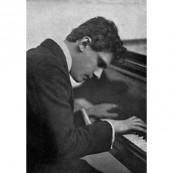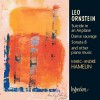传记
Leo Ornstein (born Lev Ornshteyn; Russian: Лев Орнштейн; c. December 2, 1893 – February 24, 2002)[1] was an American composer and pianist of the early twentieth century. His performances of works by avant-garde composers and his own innovative and even shocking pieces made him a cause célèbre on both sides of the Atlantic.
Ornstein was the first important composer to make extensive use of the tone cluster. As a pianist, he was considered a world-class talent.[2] By the mid-1920s, he had walked away from his fame and soon disappeared from popular memory. Though he gave his last public concert before the age of forty, he continued writing music for another half-century and beyond. Largely forgotten for decades, he was rediscovered in the mid-1970s. Ornstein completed his eighth and final piano sonata at the age of ninety-seven, making him the oldest published composer in history (a mark since passed by Elliott Carter).
Ornstein was born in Kremenchuk, a large town in the Ukrainian province of Poltava, then under Imperial Russian rule. He grew up in a musical environment—his father was a Jewish cantor, while a violinist uncle encouraged the young boy's studies. Ornstein was recognized early on as a prodigy on the piano; in 1902, when the celebrated Polish pianist Josef Hofmann visited Kremenchug, he heard the eight-year old Ornstein perform. Hofmann gave him a letter of recommendation to the highly regarded St. Petersburg Conservatory. Soon after, Ornstein was accepted as a pupil at the Imperial School of Music in Kiev, then headed by Vladimir Puchalsky. A death in the family forced Ornstein's return home. In 1903, Osip Gabrilovich heard him play and recommended him to the Moscow Conservatory. In 1904, the ten-year-old Ornstein auditioned for and was accepted by the St. Petersburg school.[3] There he studied composition with Alexander Glazunov and piano with Anna Yesipova. By the age of eleven, Ornstein was earning his way by coaching opera singers.[4] To escape the pogroms incited by the nationalist and antisemitic organisation Union of the Russian People, the family emigrated to the United States in February 1906.[5] They settled in New York's Lower East Side, and Ornstein enrolled in the Institute of Musical Art—predecessor to the Juilliard School—where he studied piano with Bertha Feiring Tapper. In 1911, he made a well-received New York debut with pieces by Bach, Beethoven, Chopin, and Schumann. Recordings two years later of works by Chopin, Grieg, and Poldini demonstrate, according to music historian Michael Broyles, "a pianist of sensitivity, prodigious technical ability, and artistic maturity
n the early 1930s, Ornstein gave his last public performance.[42] A few years later, he and his wife—the former Pauline Mallet-Prèvost, also a pianist—founded the Ornstein School of Music in Philadelphia.[43] Among the students there, John Coltrane and Jimmy Smith would go on to major careers in jazz.[44] The Ornsteins directed and taught at the school until it closed with their retirement in 1953. They essentially disappeared from public view until the mid-1970s, when they were tracked down by music historian Vivian Perlis: the couple was spending the winter in a Texas trailer park (they also had a home in New Hampshire).[45] Ornstein had continued to compose music; equipped with a powerful memory, he was not diligent about writing it all down and had not sought to publicize it for decades. Though his style had tempered greatly since the 1910s, it retained its unique character, and with his rediscovery came a new burst of productivity. In Gann's description, piano works composed by Ornstein in his eighties, such as Solitude and Rendezvous at the Lake, featured melodies that "sprang through endless ornate curlicues that brought no other composer to mind."[16]
In 1988, the ninety-five-year-old Ornstein wrote his Seventh Piano Sonata. With this composition Ornstein became, by a couple of years, the oldest published composer ever to produce a substantial new work.[46] In 1990, at the age of ninety-seven, Ornstein's final work, the Eighth Piano Sonata, was completed and given its world premiere. The names of the sonata's movements reflect not only the passage of a remarkable span of time, but an undimmed sense of humor and exploratory spirit: I. "Life's Turmoil and a Few Bits of Satire" / II. "A Trip to the Attic—A Tear or Two for a Childhood Forever Gone" (a. "The Bugler" / b. "A Lament for a Lost Boy" / c. "A Half-Mutilated Cradle—Berceuse" / d. "First Carousel Ride and Sounds of a Hurdy-Gurdy")[47] / III. "Disciplines and Improvisations". Reviewing the work's New York debut, critic Anthony Tommasini wrote, "Between the roaring craziness of the first and third movements, the middle movement is a suite of four short musical musings on childhood mementos discovered in an attic. Though completely incongruous, the shift in tone is audacious and the music disarming. The audience listened raptly, then erupted in applause."[15]
In February 2002, Ornstein died peacefully in his home in Green Bay, Wisconsin.[48] He is survived by his daughter Edith Valentine of De Pere, Wisconsin, his son, Severo Ornstein of Woodside, California, five grandchildren, and four great-grandchildren.[49][50] At the age of 108, he was among the longest-lived of composers.[51]










